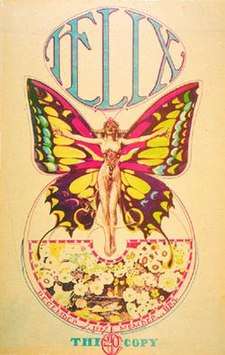Helix (newspaper)
The Helix was an American biweekly newspaper founded in 1967 after a series of organizational meetings held at the Free University of Seattle involving a large and eclectic group including Paul Dorpat, Tom Robbins and Lorenzo Milam A member of both the Underground Press Syndicate and the Liberation News Service, it published a total of 125 issues (sometimes as a weekly, sometimes as a biweekly) before folding on June 11, 1970.[1]
 December 1, 1967 issue (vol.2, #6) | |
| Type | Biweekly newspaper |
|---|---|
| Format | Tabloid |
| Editor | Paul Dorpat, Walt Crowley |
| Founded | 1967 |
| Ceased publication | 1970 |
| Headquarters | Seattle, WA |
| Circulation | 15,000 |
The first issue was produced by Paul Dorpat and Walt Crowley with $200 in borrowed capital, out of a rented storefront on Roosevelt Way NE. After being turned down by the first printers they approached, they found a printer in Ken Monson, communications director of the International Association of Machinists local, who had recently acquired a printing press. 1500 copies were printed of the first issue. By the fourth biweekly issue sales had reached 11,000 copies. After the first two issues a "split-font" rainbow effect was sometimes used to print psychedelically colorful front covers; issues averaged 24 pages, with illustrations and graphics clipped from old magazines and having little to do with the adjoining copy crammed into the interior pages.[2]
In September 1967 Helix was evicted from the office on Roosevelt Way. On October 15 they opened their new office at 3128 Harvard E., where they were to remain for the rest of the paper's existence.
Contents of the paper were a New Left/hippie mélange of underground politics, psychedelic graphics, drug culture, bulletins from the Liberation News Service, and rock music reviews, with much coverage of rock festivals in the Pacific Northwest including the Sky River Rock Festivals and concerts at Eagles Auditorium. Frequent contributors included Tom Robbins, while Walt Crowley was responsible for much of the paper's freewheeling design. The Blue Moon Tavern and the Last Exit on Brooklyn coffee house functioned as the paper's unofficial hangouts. In 1970 Robert Glessing reported that although the paper did not pay salaries it was providing food and housing for 11 full-time staffers.[3]
After the demise of the Helix several former staffers, including Crowley and Roxie Grant, went to work at a new community center called the U District Center, at the corner of NE 56th and University Way.[4] Several attempts were made by different groups in Seattle to launch a new paper to take the place of the Helix, including the New Times Journal, Puget Sound Partisan, Sabot, Seattle Flag, Seattle Sound, and the Sun, but none succeeded in recapturing the spirit or the success of the Helix.[5]
Crowley and Dorpat later went on to be two of the three founders of HistoryLink, along with Crowley's wife Marie McCaffrey.[1][6]
Notes
- Walt Crowley (January 1, 2000). "Helix, Seattle's first underground newspaper, debuts on March 23, 1967". HistoryLink.org. Retrieved October 13, 2007.
- Crowley, Walt. Rites of Passage: A Memoir of the Sixties in Seattle (University of Washington Press, 1995), p. 63, 71.
- Glessing, Robert. The Underground Press in America (Indiana University Press, 1970), p. 93.
- Rite of Passage, p. 188.
- Rites of Passage, p. 186.
- Long, Priscilla (September 21, 2007). "Crowley, Walt (1947-2007)". HistoryLink.org. Retrieved September 23, 2007.